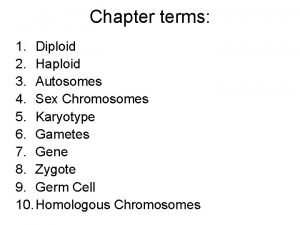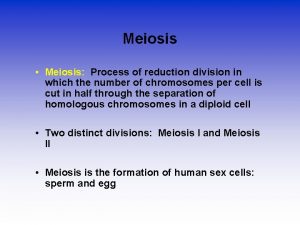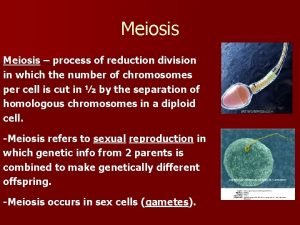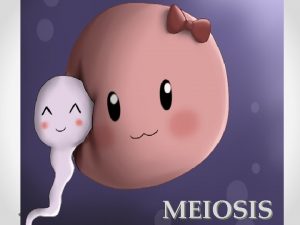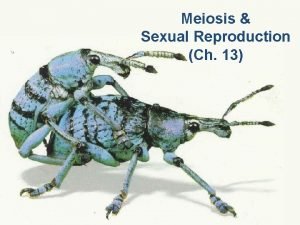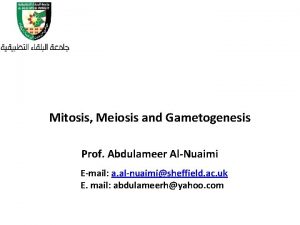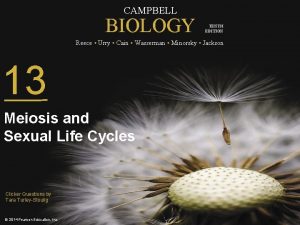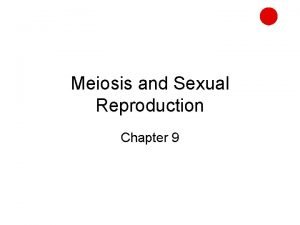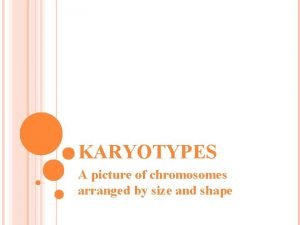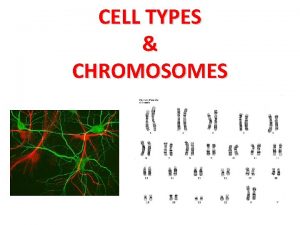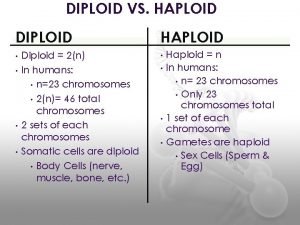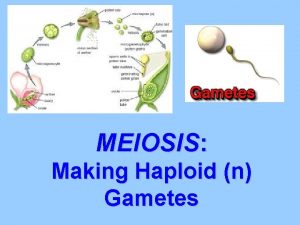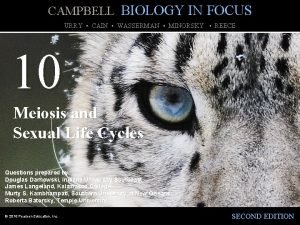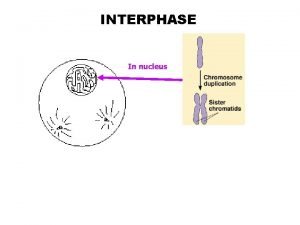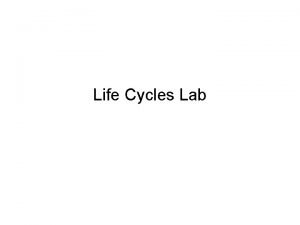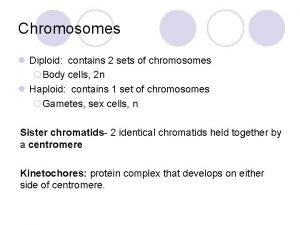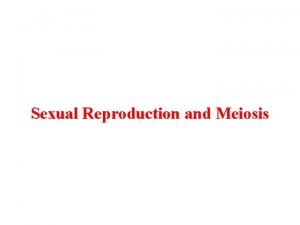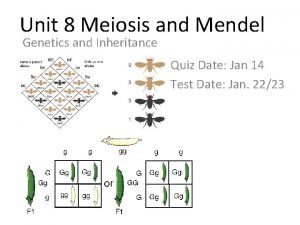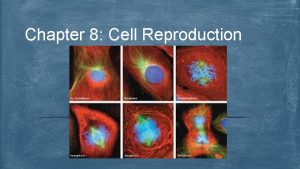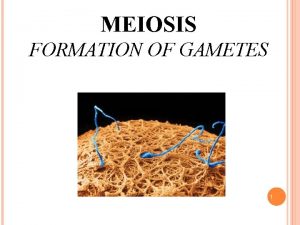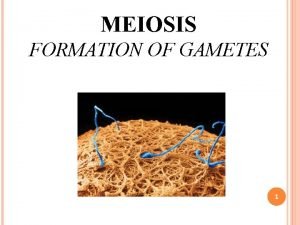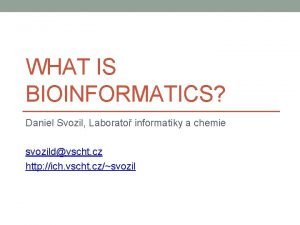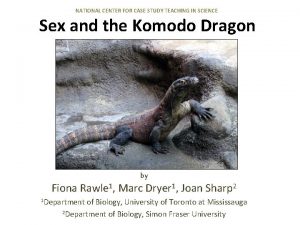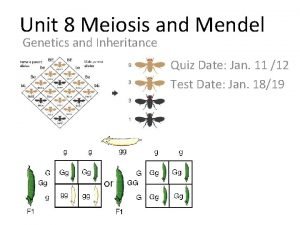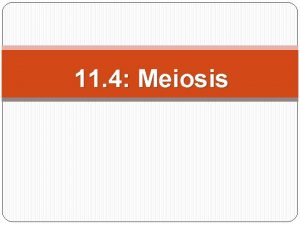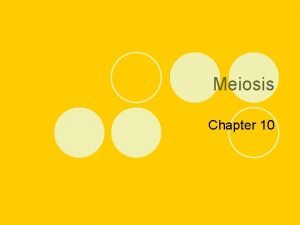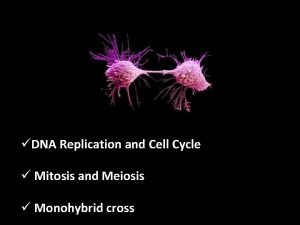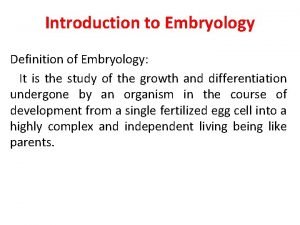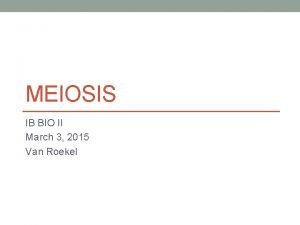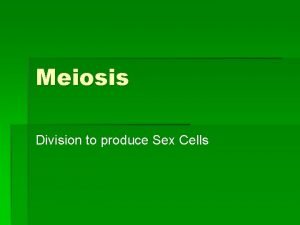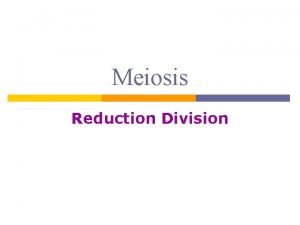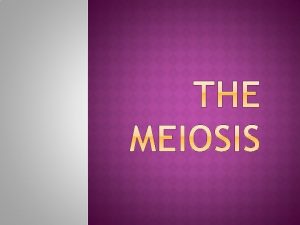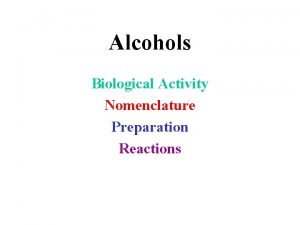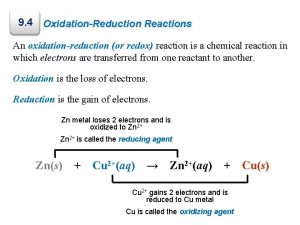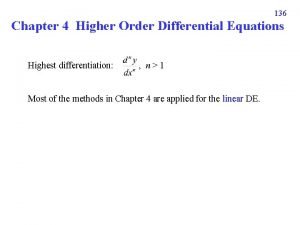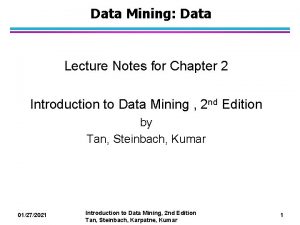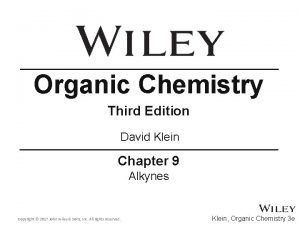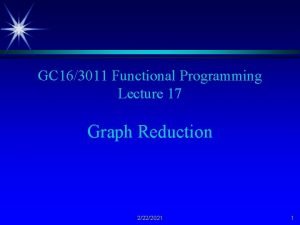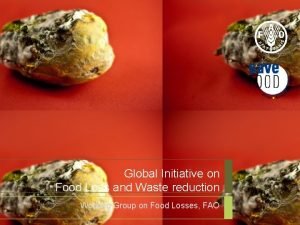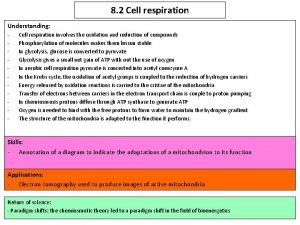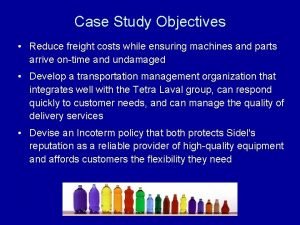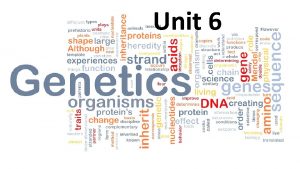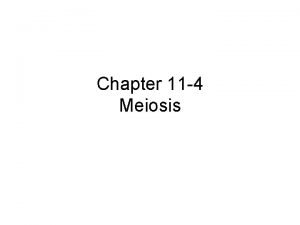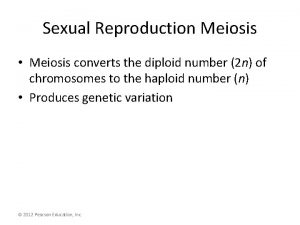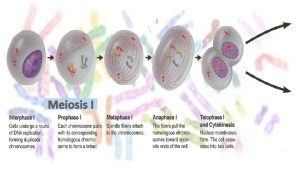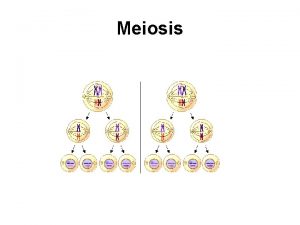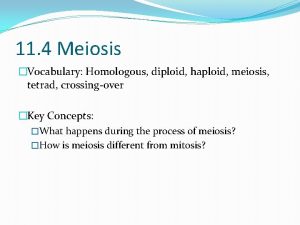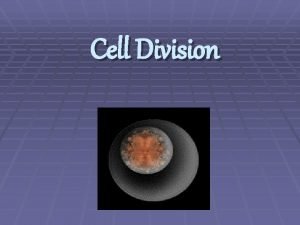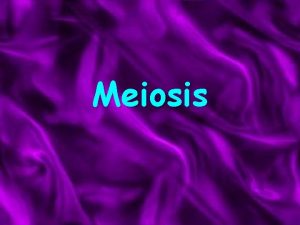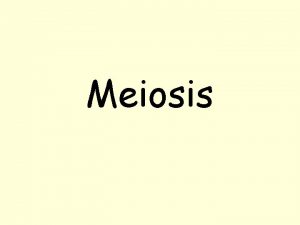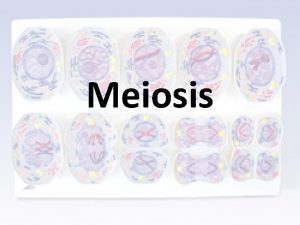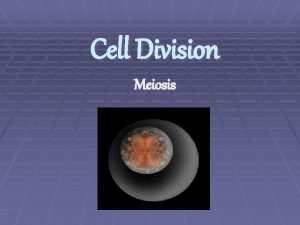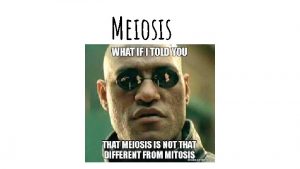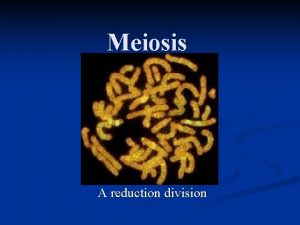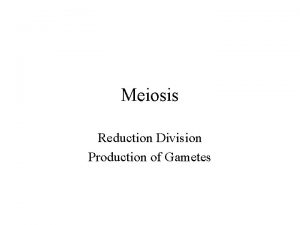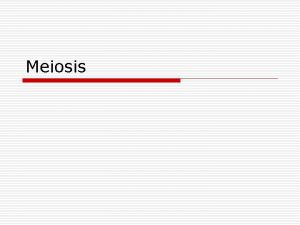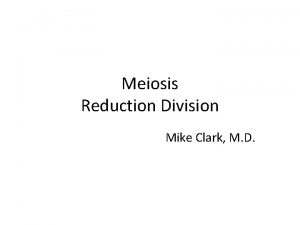MEIOSIS Meiosis A reduction division of a diploid









































































- Slides: 73

MEIOSIS

Meiosis • A reduction division of a diploid nucleus to form a haploid nuclei • The reduction form of cell division by which gametes, with half the number of chromosomes, half are produced. • Diploid (2 n) haploid (n) • Meiosis is Meiosis sexual reproduction. • Two divisions ( divisions meiosis I and meiosis II). II

Fertilization • The fusion of a sperm and egg to form a zygote. sperm egg zygote • A zygote is a fertilized egg n=23 egg sperm n=23 2 n=46 zygote

Meiosis • Cells divide to produce gametes (sperm or egg) • Gametes have half the # of chromosomes. Gametes half chromosomes • Occurs only in gonads (testes or ovaries). Male: spermatogenesis Female: oogenesis • Meiosis is similar to mitosis with some Meiosis mitosis chromosomal differences.

Spermatogenesis human sex cell n=23 sperm n=23 2 n=46 haploid (n) diploid (2 n) n=23 meiosis II

Meiosis – mouse testes Parent cell 1 st division 2 nd division 4 gametes

Interphase I • Similar to mitosis interphase. mitosis • Chromosomes replicate (S phase). Chromosomes • Each duplicated chromosome consist of two chromosome identical sister chromatids attached at their chromatids centromeres • Centriole pairs also replicate. Centriole

Interphase I • Nucleus and nucleolus visible. Nucleus nucleolus chromatin nuclear membrane cell membrane nucleolus

Meiosis I (four phases) • Cell division that reduces the chromosome number by one-half. • four phases: phases a. prophase I b. metaphase I c. anaphase I d. telophase I



spindle fiber aster fibers centrioles


Prophase I • Longest and most complex phase (90%). • Chromosomes condense and pair up Chromosomes • Synapsis forms: homologous chromosomes Synapsis come together to form a tetrad or a bivalent tetrad • Tetrad = two chromosomes or four chromatids Tetrad chromosomes (sister and nonsister chromatids).

Prophase I - Synapsis Homologous chromosomes sister chromatids Tetrad sister chromatids

Homologous Chromosomes • Pair of chromosomes (maternal and paternal) paternal that are similar in shape and size. • Homologous pairs (tetrads) carry genes controlling the same inherited traits. • Each locus (position of a gene) is in the same position on homologues. • Humans have 23 pairs of homologous chromosomes. a. 22 pairs of autosomes b. 01 pair of sex chromosomes

Homologous Chromosomes eye color locus hair color locus Paternal Maternal

Crossing Over • Crossing over (variation) may occur between nonsister chromatids at the chiasmata. chromatids chiasmata • Crossing over: segments of nonsister over chromatids break and reattach to the other chromatids chromatid • Chiasmata (chiasma) are the sites of crossing over

Crossing Over variation nonsister chromatids Tetrad chiasmata: site of crossing over variation

Another Way Meiosis Makes Lots of Different Sex Cells – Crossing-Over Crossing-over multiplies the already huge number of different gamete types produced by independent assortment

Sex Chromosomes XX chromosome - female XY chromosome - male

Prophase I spindle fiber aster fibers centrioles

Faze profaze I: 1. LEPTOTEN (A) - kromosomi(dvostruki) nalikuju tankim nitima u klupku - uočavaju se KROMOMERE –jače spiralizirana mjesta (stoga jače obojena) YO U DO NOT 2. ZIGOTEN(B) NEED TO - još se opaža jezgrica K NOW - SINAPTONEMSKI KOMPLEKS – struktura koja omogućuje sparivanje THIS homologa u bivalent - kromomere jednog kromosoma se “poslože” uz analogne kromomere drugog homologa i spoje se preko sinap. komp. 3. PAHITEN (C) - završeno je sparivanje homologa -zbiva se crossing over, vidljive hijazme http: //www. as-botanicalstudies. com/content/54/1/46/figure/F 3

YOU D O NOT NEED KNOW TO THIS 4. DIPLOTEN (D) - zbog razgradnje sinaptonemskog kompleksa popušta veza među homolozima - homolozi povezani preko hijazmi - kromosomi se skraćuju(kondenziraju), deblji su 5. DIJAKINEZA (E) - daljnja kondenzacija, sada su vidljive sve četiri kromatide bivalenta http: //www. as-botanicalstudies. com/content/54/1/46/figure/F 3

Pollard: Cell Biology, 3 rd edition

• • Aceto-carmine stained normal (A-M) & abnormal (N-T) meiotic stages of Aloe vera. (A) Leptotene stage. (B) Zygotene stage showing chromatin threads (C) Pachytene stage showing beaded chromosomes. (D) Diplotene stage showing ‘X’ shaped chiasma. (E) Diakinesis showing 7 bivalents with 4 long and 3 short chromosome pairs. (F) Side view of metaphase-I. (G) Side view of anaphase-I. (H) Side view of telophase-I. (I) Side view of prophase-II (J) Side view of metaphase-II. (K) Side view of anaphase-II. (L) Side view of telophase-II. (M) Tetrad showing 4 pollen grains. (N) Side view of anaphase-I with single chromosomal bridge and lagged chromosome. (O) Side view of anaphase-I with double chromosomal bridge. (P) Side view of anaphase-I with single chromosomal bridge (Q) Telophase-I with lagged chromosome. (R) Metaphase-II with lagged chromosome. (S) Telophase-II with single chromosomal bridge. (T) Telophase-II with univalent laggard chromosome. Haque and Ghosh Botanical Studies 2013 54: 46 doi: 10. 1186/1999 -3110 -54 -46 http: //www. as-botanicalstudies. com/content/54/1/46/figure/F 3

http: //www. as-botanicalstudies. com/content/54/1/46/figure/F 3

Metaphase I • Shortest phase • Tetrads align at the eqator of the cell (chiasmata are Tetrads eqator in the equatorial plane = metaphase plate) o Moved through the cell by spindle microtubules • INDEPENDENT ASSORTMENT OCCURS: 1. Orientation of homologous pair to poles is random. 2. Variation 3. Formula: 2 n Example: 2 n = 4 then n = 2 thus 22 = 4 combinations

Metaphase I OR metaphase plate


Question: • In terms of Independent Assortment -how many different combinations of sperm could a human male produce?

Answer • Formula: 2 n • Human chromosomes: 2 n = 46 n = 23 • 223 = ~8 million combinations

Anaphase I • Homologous chromosomes separate and move towards the poles. • Sister chromatids remain attached at their centromeres

Anaphase I


Telophase I • Each pole now has haploid set of haploid chromosomes • Chromosomes uncoil. • Cytokinesis occurs and two haploid daughter Cytokinesis cells are formed.

Telophase I


Meiosis II • No interphase II (or very short - no more DNA replication) replication • Meiosis II is similar to mitosis


Prophase II • same as prophase in prophase mitosis


Metaphase II • same as metaphase in metaphase mitosis metaphase plate


Anaphase II • same as anaphase in anaphase mitosis • sister chromatids separate


Telophase II • Same as telophase in telophase mitosis • Nuclei form. • Cytokinesis occurs. Cytokinesis • Remember: four haploid daughter cells produced. gametes = sperm or egg

Telophase II


Meiosis sex cell n=2 sperm n=2 2 n=4 haploid (n) diploid (2 n) n=2 n=2 meiosis II

Variation • Important to population as the raw material for natural selection. • Question: What are three sexual sources of genetic variation?

Answer: 1. crossing over (prophase I) 2. independent assortment (metaphase I) 3. random fertilization Remember: variation is good!

Question: • A cell containing 20 chromosomes (diploid) at the beginning of meiosis would, at its completion, produce cells containing how many chromosomes? chromosomes

Answer: • 10 chromosomes (haploid)

Fertilization • The fusion of a sperm and egg to form a zygote. sperm egg zygote • A zygote is a fertilized egg n=23 egg sperm n=23 2 n=46 zygote

Question: • A cell containing 40 chromatids at the chromatids beginning of meiosis would, at its completion, produce cells containing how many chromosomes? chromosomes

Answer: • 10 chromosomes

Did u know? Humans =46 Great apes = 48 Human chromosome 2 was formed by a merger of ancestral chromosomes, reducing their number.

Humans have 23 Sets of Homologous Chromosomes Each Homologous set is made up of 2 Homologues. Homologue

KARYOTYPE KARYOGRAM IDIOGRAM

KARYOTYPE – is the number and appearance of chromosomes in the nucleus of a eukaryotic cell

KARYOGRAM – a graphic representation of the complete set of human chromosomes

IDIOGRAM – the diagrammatic representation of a karyotype - it may be based on measurements of the chromosomes

http: //learn. genetics. utah. edu/content/chromosomes/karyotype/

Autosomes (The Autosomes code for most of the offspring’s traits) In Humans the “Autosomes” are sets 1 - 22

Sex Chromosomes The Sex Chromosomes code for the sex of the offspring. If the offspring has two “X” chromosomes it will be a female. If the offspring has one “X” chromosome and one “Y” chromosome it will be a male. In Humans the “Sex Chromosomes” are the 23 rd set XX chromosome - female XY chromosome - male

Boy or Girl? The Y Chromosome “Decides” Y chromosome X chromosome

21 trisomy – Downs Syndrome Can you see the extra 21 st chromosome? Is this person male or female?


Cross section through a testis



Sources • www. ursulinehs. org/powerpoint/meiosis. ppt • www. biology 4 teachers. com/Cell%20 Division/MEIOSIS. p pt • http: //www. iteachbio. com/Life%20 Science/Life. Functions and. The. Cell/Meiosis. ppt
 Why is meiosis important?
Why is meiosis important? Diploid vs haploid
Diploid vs haploid Process of reduction division
Process of reduction division Process of reduction division
Process of reduction division Tetrad meiosis
Tetrad meiosis When does crossing over occur during meiosis?
When does crossing over occur during meiosis? Prophase ii meiosis
Prophase ii meiosis What is the difference between mitosis and meiosis 2
What is the difference between mitosis and meiosis 2 Kelly reidell
Kelly reidell Chapter 10 section 1 meiosis answer key
Chapter 10 section 1 meiosis answer key Meiosis 1 vs meiosis 2
Meiosis 1 vs meiosis 2 Chapter 10 section 10.2 meiosis worksheet answer key
Chapter 10 section 10.2 meiosis worksheet answer key Primary spermatocyte
Primary spermatocyte Primary oocyte haploid or diploid
Primary oocyte haploid or diploid Somatic vs gamete
Somatic vs gamete Privet shrubs and humans each have a diploid number of 46
Privet shrubs and humans each have a diploid number of 46 Advantage of sexual reproduction
Advantage of sexual reproduction Pictures of chromosomes arranged in pairs
Pictures of chromosomes arranged in pairs Diploid cell
Diploid cell Diploid vs haploid number
Diploid vs haploid number What is haploid and diploid
What is haploid and diploid Gametes
Gametes Privet shrubs and humans each have a diploid number of 46
Privet shrubs and humans each have a diploid number of 46 Number of divisions in mitosis
Number of divisions in mitosis Diplod
Diplod Diploid contains 2 sets of chromosomes
Diploid contains 2 sets of chromosomes Produces haploid cells
Produces haploid cells Practice haploid v. diploid answer key
Practice haploid v. diploid answer key Diploid vs haploid number
Diploid vs haploid number Primary oocyte haploid or diploid
Primary oocyte haploid or diploid Polar body
Polar body Daniel svozil
Daniel svozil What is diploid
What is diploid Haploide zelle
Haploide zelle How could oogenesis be modified to produce diploid eggs
How could oogenesis be modified to produce diploid eggs Chromosome number of human
Chromosome number of human Diploid cells
Diploid cells Primary oocyte haploid or diploid
Primary oocyte haploid or diploid Diploid cell
Diploid cell Diploid cell
Diploid cell Dna structure and replication pogil
Dna structure and replication pogil Phases of oogenesis
Phases of oogenesis Why is meiosis referred to as reductional division
Why is meiosis referred to as reductional division Meiosis
Meiosis Meiosis division
Meiosis division Why is meiosis referred to as reductional division
Why is meiosis referred to as reductional division Mitosis meiosis
Mitosis meiosis Why is meiosis referred to as reductional division
Why is meiosis referred to as reductional division Division short form
Division short form Synthetic division examples with answers
Synthetic division examples with answers Short division vs long division
Short division vs long division How to synthetic division
How to synthetic division Na2cr2o7 h2so4
Na2cr2o7 h2so4 Drive reduction theory ap psychology
Drive reduction theory ap psychology Code reduction alitalia
Code reduction alitalia Oxidation half reaction
Oxidation half reaction Model order reduction
Model order reduction Transference psychology
Transference psychology Tollens reduction
Tollens reduction Annihilator operator
Annihilator operator Reactivity of carboxylic acid
Reactivity of carboxylic acid Drive reduction theory
Drive reduction theory Types of attributes in data mining
Types of attributes in data mining Hydroboration of alkynes
Hydroboration of alkynes Sugar reduction the evidence for action
Sugar reduction the evidence for action Harm reduction
Harm reduction Soft bender rod
Soft bender rod Graph reduction
Graph reduction Food loss and waste
Food loss and waste Percent decrease calc
Percent decrease calc Numerosity reduction
Numerosity reduction Respirometer
Respirometer Oxidation reduction reactions chapter 19 review
Oxidation reduction reactions chapter 19 review Freight cost reduction case study
Freight cost reduction case study

